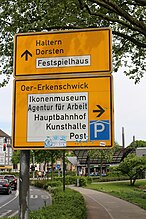Signposting
The signposting comprises the entirety of the measures and facilities for finding and guiding road users in road traffic. With the help of the signposting, which is part of the road equipment, road users who are unfamiliar with the location can orient themselves while driving and thus prevent wandering. For the fulfillment of this task it is necessary that the signposting is clear and clear. Signposting usually includes static and dynamic (pre) signposts , place-name signs , street signs and house numbers .
tasks
The signage primarily serves the following tasks:
- Finding the destination
- Location determination
- Detour-free destination finding
- Control of traffic flows
- Signpost in Germany
Basic rules
When designing and arranging the signage, eight basic rules must be observed:
- uniformity
- The signposting should have a uniform appearance throughout the transport network.
- Perceptibility
- Good visibility of the signposting at any time of the day or year is essential. This can be ensured by appropriate foils (retroreflection) on the signposting. Furthermore, important signs can also be illuminated. The so-called button copy technique is considered obsolete .
- Readability
- The information density for signposting should be as low as possible in order not to overwhelm road users. The number of destination information on the signage must therefore be limited and, if possible, depicted using pictograms.
- Target selection
- Depending on the function of the road, suitable destination information must be selected. In general, a distinction is made between long-term and short-term goals.
- continuity
- If a destination is mentioned in the signposting, it must be shown again and again along the entire route to the destination until the road user has reached the destination. Destinations can be target points (e.g. stadium or clinic ) or target areas (e.g. old town or Berlin ). The continuity of the route guidance is given if the destination is shown at all intersections at which a turn has to be made and if the destination is shown at all intersections which have signposting. Arrow signs that only point other destinations to the right or left are an exception. It is not necessary to state the destination here if you have to drive straight ahead. A break in the continuity is referred to as a "target termination".
- Fold rule
- The signposting is to be arranged in such a way that if the signpost is intended to be folded onto the lane (in the direction of travel) the actual order of the destinations is indicated. If there are several goals, one below the other, the top goal is therefore the most distant. The same applies to several arrows pointing in the same direction (often e.g. at motorway junctions). The content of the signpost is only clearly understandable for road users through the fold-down rule.
- Arrows
- In order to better indicate the direction of targets, the sign can be designed as an arrow (arrow signpost). More often, however, directional arrows are assigned to the destination information on a rectangular board (table signpost, signpost) or the course of the road is shown schematically (signpost).
- colour
- The colors of the directional signs depend on the location and the destination. Combinations of different target types (i.e. colors) on a signpost are possible.
Norms and standards

Cleaning a signpost ( D , sign 439)
- Germany
- Road Traffic Regulations (StVO)
- General administrative regulation for road traffic regulations (VwV-StVO)
- Guidelines for directional signage outside of the Autobahn (RWB)
- Leaflet on trailblazing signage for cycling. Cologne 2013 (regulated in more detail at the state level by "Notes on trailblazing signage for cycling" (HBR), e.g. in North Rhine-Westphalia , Rhineland-Palatinate and Brandenburg )
- Guidelines for directional signage on motorways (RWBA 2000)
- Leaflet on the signposting for pedestrian traffic
- Guidelines for diversion signage (RUB)
- Austria
- Road Traffic Regulations (StVO)
- RVS 05.02.12 Design and signposting
- RVS 05.02.13 Signage and directional signs on motorways
- Switzerland
- Road Traffic Act (SVG)
- Signalization Ordinance (SSV)
- SN 640817d - road signals; Signposts on main and secondary roads for general traffic
- SN 640804 - Traffic control on motorways and motorways; Change of direction
Individual evidence
- ^ Research Society for Roads and Transport: Definitions, Part: Transport Planning, Road Design and Road Operation . FGSV Verlag, Cologne 2000, p. 78 .
- ^ Natzschka: Road construction, design and construction technology. BG Teubner Verlag, 2011, ISBN 978-3-8348-1343-5 , page 430.



